Thursday, December 24, 2009
Merry Christmas and Happy New Year!
Happy Holidays!
Thursday, December 17, 2009
Armchair gardening with a little help from NPR

I've often thought of designing a garden containing nothing but poisonous plants, so this one is right up my alley.
Anyone else out there in blog-land have some favorite gardening books to recommend? 'Tis the season for some armchair gardening.
Wednesday, October 21, 2009
How to Ripen Green Tomatoes
Here's what to do:
1. Pick all your green tomatoes that look remotely mature and are in good shape. They should have something close to their mature shape, be somewhat close to their mature size, and not have bruises, soft spots, insect damage, or other major yucky spots.
2. Rinse or wipe them off.
3. Put them in in a single layer in some kind of container and cover them to keep out fruit flies and other pests. I use paper shopping bags. I put a layer of tomatoes in the bottom, fold the tops down to keep out pests, and put the bags in plastic trays to keep any tomato guts from dripping onto the carpet.
4. Store them somewhere dry and warm (warm as in room temperature, not warm as in Mojave Desert in August). According to a Wikipedia article, tomatoes stop ripening when the temperature drops below 54.5 °F (12.5 °C).
5. Check them regularly, removing any that are a) ripe or b) nasty. I check mine each week.
This method has worked well for me for years. Sometimes I still have fresh tomatoes at Thanksgiving, and I don't have to coerce my defenseless family into eating green tomatoes. What's not to love?
Tuesday, October 20, 2009
Heirloom apples
We couldn't make it to the apple tasting, but Jacqueline at Friendly Haven Rise Farm, who sponsored the tasting, invited us up to visit their farm and purchase some heirloom apple trees. The trees they sell come from an older gentleman who grows over 1000 (!!) varieties of apples, including several that even Google had never heard of. We had a lovely visit, brought home a couple of trees, and look forward to growing our own heirloom apples. If you'd like to do the same and you're within driving distance of Southwest Washington, I suggest you call the good folks at Friendly Haven Rise Farm to see if they have some trees left. You might also check out the heirloom apple tasting in Parkdale, OR, this weekend. If you're out of the area, try Trees of Antiquity, which seems to have a good selection (note: I've never done business with them, so I can't vouch for anything other than the impressive list of varieties on their web site). You too can grow your own little piece of history--a delicious little piece that will taste great in a pie.
Hmm... that last sentence should net me some interesting referral traffic. It might even compete with the infamous deer anus post on my personal blog.
Friday, September 25, 2009
Tracking climate change in your own backyard
Tuesday, August 18, 2009
75 Things You Can Compost
- yard waste, grass clippings, etc. - a/k/a the usual
- vegetable food scraps that don't go to the chickens
- napkins
- tissue paper
- newspaper used to wash windows (the extra ammonia is a good source of nitrogen, right?)
- used paper plates
- egg shells
- dead houseplants and their soil
- shredded paper (we shred anything an identity thief might find useful)
- jack o'lanterns
- nut shells, coconut hulls, etc.
- the disgusting sludge I clean out of the sink strainer (ewwwww)
- pencil shavings
- dryer lint - but be sure to bury it in the pile. The first time I composted dryer lint, I felt very virtuous. About 2 days later we had a big windstorm, and I found dryer lint all over my front yard. Ugh.
- cedar shavings from the bottom of the corn snake's tank. I'm not sure it's really proper to compost them, because reptile poop contains salmonella, but I figure a) people compost chicken manure, which often contains salmonella, b) the snake smell might deter the giant rats (think ROUS's from The Princess Bride) that often seek food and shelter in our compost bins, and c) we don't eat our compost.
After one of my Facebook friends commented that her husband bleeds on the compost pile when he cuts his finger (blood is a good source of nitrogen, right?), I thought maybe I should have composted my husband's bloody bandages from his last surgery. But I'm pretty sure that falls into the same category as the used condoms: compostable, yes, but it pushes the limits a bit.
Sunday, July 26, 2009
Tomatoes: sex, death, and cigarettes
The enigmatic tomato belongs to the same family as tobacco and the toxic, deadly nightshade, but that just adds to its glamour. Sex, death and cigarettes: Eden's forbidden fruit should have been a tomato.
And they mention a tomato-wrestling contest. Fabulous!
Wednesday, June 10, 2009
Son of Stinky!

(photo from Flickr user whatsthatpicture)
I know this has absolutely nothing to do with gardening in the Northwest, but I just can't resist posting it here. Nicknamed "Son of Stinky," another corpse flower is about to bloom at the Huntington Library. I so want one of these in my garden! It's huge, it stinks, and it has the best botanical name I've ever heard: Amorphophallus titanum (which literally means "giant misshapen penis" -- thank you, Wikipedia!) If it were carnivorous, it would be perfect. Then I could feed my obnoxious neighbors to it. Just imagine the possibilities. This thing would make Audrey look like a wimp. Feed me, Seymour...
Hmm... maybe I've been inhaling too many compost fumes...
Thursday, May 28, 2009
When Is a Weed Not a Weed?
I keep feeling like the fact it is a weed means I should be yanking it out. Bad weed, bad! But at the same time, I am tempted to just enjoy it. It seems happy. I seem happy. Maybe weeds don't always have to be weeds? Anybody know what this is, by the way?

Monday, May 25, 2009
Dateline SoCal (or, No Rainy Day Gardening Here)
Oleander
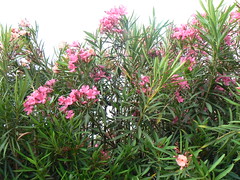
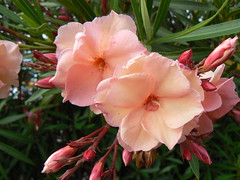
Oleander is everywhere, both in SoCal and where I grew up. It's often found growing alongside the freeway, or in the case of the ones in these pics, growing alongside a gas station parking lot in LA. They're kind of like rhodies are in the maritime Northwest - all-purpose, low-maintenance shrub found in just about every garden, overused to the point of being boring. Every now and then, I find them advertised for sale in catalogs of tropical plants, listed alongside orchids and other exotics (and with prices to match). I just laugh and wonder what the buyers would think if they could see their precious tropical shrub next to a California freeway.
Then there's this beauty--the Bird of Paradise:
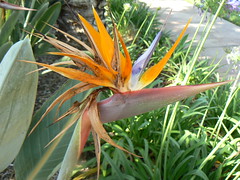
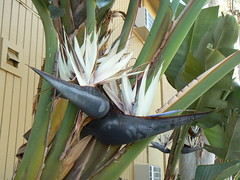
My grandmother had one of these in front of her house in Oakland when I was a kid. Up here, like oleander, they're sold as pricey tropicals. Until this trip, I never noticed that there was more than one variety. The colorful one is the one I remember seeing all the time. The other one isn't as pretty IMHO, but it's way larger. The blooms are about twice the size of the colorful ones.
The pictures above were all taken just outside Disneyland. This one was taken inside the park, in Fantasyland to be precise. Just look at these delphiniums!
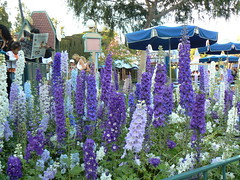
They belong in Fantasyland too. I think I'd have better luck spotting Tinkerbell in my garden than growing delphiniums that look that good. Apparently Fantasyland is not only where dreams come true; it's also where slugs don't exist.
In addition to Disneyland, we paid a visit to San Gabriel Mission, or as it's officially known, Mission San Gabriel Archangel. There's some very nice landscaping outside the mission, including this striking cactus, which really pops against the adobe wall of the mission and alongside the rounded shrubs:
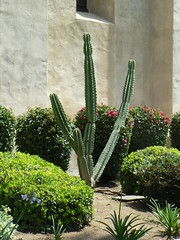
The mission includes a peace garden in the courtyard, with a lovely collection of succulents and other desert plants. Here's a sampling:

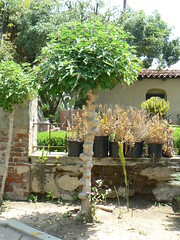
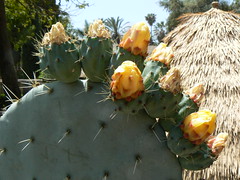

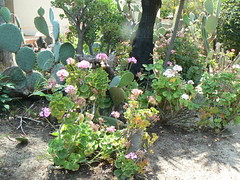
Yes, those are geraniums (or pelargoniums for you horticultural purists) in that last pic. They become shrubs when left to their own devices in places with mild winters.
So there ya go--a glimpse or two of flora from the Granola State. I hope you enjoyed this bit of armchair travel with your Rainy Day Gardening correspondent. Now, back to your regularly-scheduled maritime climate...
Tuesday, May 19, 2009
Dramatic Discovery in Halifax, Nova Scotia's Public Garden
In the meantime, I wanted to show you guys this totally cool flower I came across two weeks ago when I was in Nova Scotia exploring the Halifax Public Garden. It was one of only a few things actually in bloom (the public garden had just opened for the season), but it had a bunch of these dramatic plants and I totally fell in love with them!
 When I got back from my trip, I tried to find out what this flower was -- it's super spiffy looking, eh? But my friends were of little help ("Sideshow Bob flower?" was one of their suggestions -- thanks, guys). So, I contacted the Plant Answer Line at the Elizabeth C. Miller Library at the University of Washington for help.
When I got back from my trip, I tried to find out what this flower was -- it's super spiffy looking, eh? But my friends were of little help ("Sideshow Bob flower?" was one of their suggestions -- thanks, guys). So, I contacted the Plant Answer Line at the Elizabeth C. Miller Library at the University of Washington for help.And here's what I learned:
This is a Fritillaria imperialis, commonly called a Crown Imperial, which is a bulbous plant that thrives in moist, free-draining, rich soil in full sun to light shade. I had asked if it was something that would grow well in the Pacific Northwest (spring in Halifax, Nova Scotia seemed a lot like spring in Seattle, as it rained most of the time I was up there!), and the answer is yes!
So, hey, guess what! I'm going to plant some. You plant them in the Fall, which is good because that gives me time to actually find the bulbs. And then they bloom in early Spring. Yay, I learned something! And then I taught it to someone else! Hooray for blogs!
Buried treasure in the garden
Unfortunately, I've never found anything that interesting in my garden. We bought our house in 1996, a few months after the property had flooded. When we started working on our washed-out mud slab of a yard, we dug up all sorts of odd things that had been washed there by the floodwaters. We found lots of bottles (and broken pieces of bottles), chunks of asphalt, and my personal favorite: sand bags. Lots of sand bags. 80-lb sand bags, buried just under the surface of my tomato-patch-in-the-making. Since we have heavy clay soil, the sand made a nice soil amendment, but it was backbreaking work to dig up the half-rotted sand bags and disperse the sand. I kept hoping I'd find some cool relic deposited by the floodwaters, but debris and sandbags were it. Maybe I should move back to Georgia.
Nah.
Sunday, March 22, 2009
Using up those parsnips
Anyway... Last night I made the best mashed potatoes I've ever made--and they weren't just mashed potatoes. They were mashed potatoes and parsnips, loaded with a bunch of unhealthy stuff like bacon and cheese. YUM. You can find the recipe for loaded mashed potatoes and parsnips at http://homecooking.about.com/od/vegetablerecipes/r/blv329.htm. I substituted chicken broth for the milk, since I don't like milk much, and they were still wonderful.
While I was searching for parsnip recipes, I found a few more that sounded good, but I haven't tried them yet.
Happy parsnip cooking!
Saturday, March 21, 2009
Another Hit and Run
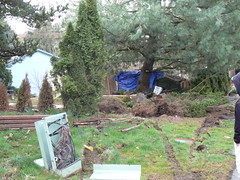
That's a telephone box in the foreground. The tall green shrub to the left is a mature arborvitae, fortunate enough to still be standing. The blank space to the right used to have about 5 more just like it, but they were mowed down. See them lying on their sides?
Here's a closeup of the carnage:
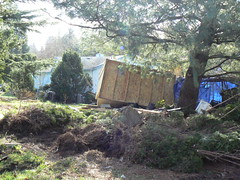
That big wooden thing is the bottom of our shed.
Speaking of the poor defenseless shed, here it is, just after the accident at o'dark thirty:
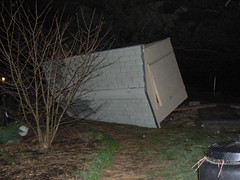
I think it looked much better standing upright, don't you?
The sheriff's deputy called us this afternoon to report that the vehicle had been identified -- a stolen van found abandoned by whomever took the joyride through our hedge. If they ever catch him, I'd like to bury him at the base of the remaining arborvitae. It seems only fitting.
Monday, March 09, 2009
March Madness, and I Don't Mean Basketball
 It’s March now in the Pacific Northwest (um, as well as everywhere else in the world, if you want to get all particular about it), but it’s certainly not very spring-like, I must say. I was actually feeling bad last week about the fact I still hadn’t pruned my roses (I’ve been nursing a shoulder injury the last few weeks and have been kind of out of commission) (AGAIN), when suddenly, wham!, we got snowed on up here again.
It’s March now in the Pacific Northwest (um, as well as everywhere else in the world, if you want to get all particular about it), but it’s certainly not very spring-like, I must say. I was actually feeling bad last week about the fact I still hadn’t pruned my roses (I’ve been nursing a shoulder injury the last few weeks and have been kind of out of commission) (AGAIN), when suddenly, wham!, we got snowed on up here again. The downside: This just provides more fodder for the “global warming” snarkers, who tend to be melodramatically literal when it comes to that phrase.
The upside: Now I look like the smart one for not having sliced and diced the roses! Despite the freaky weather, it’s actually time to start planting some stuff outside, as wholly unappealing as THAT sounds this morning. (Current temperature: 36 degrees. Forecasted high for the day: 36 degrees. Current mood: Fine, you know what? I'm going back to bed. Forecasted mood for the day: Wake me up in April. IF YOU DARE.)
Yep, according to my expert resources, those of us who live in the Pacific Northwest can begin sowing the following seeds outside:
- Many types of lettuce and other leafy greens (unless you, like me, find leafy greens wholly uncooperative)
- Asparagus (shoot (ha!), I really wanted to plant asparagus this year and haven’t moved on it -- can I plant it as late as the first weekend in April, fellow PNW gardeners?)
- Beets (ew)
- Carrots (some year I will try them in pots)
- Peas (yay! yay! yay!)
- Parsnips (delicious and strange)
- Potatoes (could be fun)
- Radishes (overrated)
- Turnips (underrated)
- Chives (pretty)
- Cilantro (pukey)
- Parsley (munchable)
Chives and parsley are also two favorites of mine. I almost never eat either one, but I love letting my chives to go flower because the flowers are so pretty (see photo above), and parsley is nice to munch on when I’m out watering things in the summer. Refreshing and chompy.
Cilantro I’m allergic to (hence the description of it as "pukey"), but my husband loves it so maybe I should humor him and put some in this year.
Nah.
Early spring is also a good time to pick up new fruit trees and get them planted -- just make sure the danger of frost is past, or that you’ve got plans on how to protect your yard noobs from extremely cold nights (reminder: it snowed several inches in Seattle last April, so don’t think it’s all over just because you’ve turned another calendar page!). We planted blueberries in our yard two springs ago right about this time, and both bushes are really thriving.It's a real thrill getting to pick and eat my own blueberries, and I'm eager to see how the raspberry I planted last year will do this year as well.
Berries -- man, hurry UP, summertime!!
Also doable this March: trim back your woody herbs (lavender, rosemary, and sage, in particular), fertilize trees and shrubs (including rhodies, which I really need to do soon), start prepping your veggie beds for planting next month, and when you’re done working outside, go back inside and start sowing your tomato seeds in containers to get them ready to go outdoors in about 6-8 weeks. If you’ve never planted golden/yellow cherry tomatoes before, I urge you to give them a shot this year -- almost as delicious as berries, and just about as sweet too!!
Still having trouble getting yourself motivated to work outside in the rain, snow, sleet, and hail? Dudes, I hear you. In that case, maybe you need to spend another couple of weeks looking at seed catalogs and day-dreaming instead. To that end, allow me to present you with this list of the Top 10 Most Productive Crops for the Pacific Northwest (from Mother Earth News):
- Pole snap bean
- Snow/snap pea
- Potato
- Garlic
- Cherry tomato
- Summer squash
- Chard
- Lettuce
- Onion
- Carrot
Spring ho!
Wednesday, March 04, 2009
A smaller, more practical Yard, Garden & Patio Show
The Yard, Garden & Patio show is the unofficial kickoff of gardening season here in Portland. It's held at the Oregon Convention Center and features exhibits from landscapers, nurseries, and other purveyors of fine garden-related products. Several of the landscapers create mammoth landscapes for the show, usually including waterfalls and full-scale gardens. One year they even created a small lake in the middle of the exhibit hall, complete with a canoe bobbing next to a dock. Seriously. This year, though, the show was smaller and less ostentatious. Apparently the lousy state of the economy is taking its toll.
There were still some big landscape displays, but there were fewer, smaller, and more in keeping with the current back-to-frugality movement. Several included vegetables mixed in with the usual landscape plants, a nice way to show that edibles can be attractive as well as functional. Here's an example:
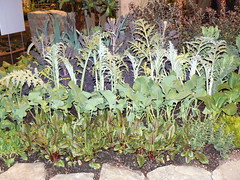
Of course, most of these veggies are planted way too close together, but they do look pretty.
A couple of the landscape displays also featured chickens, which are becoming very popular here in Portland. Here's a small veggie garden display, complete with egg-y looking chicken coop (and chickens):
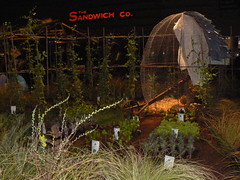
I especially appreciate these trends, as I think anyone who has even a little bit of sun in their yard can grow a few vegetables, even if they live in one of those we're-better-than-you subdivisions that ban sensible things like clotheslines and vegetable gardens. Go ahead... tuck that chard in between your barberries. Slip some basil under the roses. Your snooty neighbors won't recognize them as edible, since they probably think a vegetable's natural habitat is the produce section at Whole Foods. If you're lucky, they'll think you're the first on the block to discover the latest trendy bedding plant. If they ask you what it is, give 'em the Latin name, which will boost your snob factor and make them even more envious. It's so new it doesn't even have a common name yet! I must have Joe the Gardener plant 50 of them. Now.
OK, OK, I digressed again, didn't I? Maybe I should call this blog Rainy Day Digressions. Anyway... back to the Yard, Garden & Patio Show. There were some notable absences this year (besides the giant lake): Fred Meyer wasn't there, and neither was Metro or my favorite orchid vendor from Hawaii. There were others missing too, though I can't remember exactly which ones. The wine section, however, was larger than usual. About 2 rows of booths were devoted to wineries pouring (and selling) their wares. The economy sucks? Drink your troubles away! I was pleasantly surprised to see that the big displays used fewer bedding plants, which in past years have been tossed in the dumpster after the show (and in some cases removed from the dumpster by Yours Truly). I asked one of the landscapers, and he assured me that they weren't throwing any plants away this year. While that puts a crimp in my dumpster-diving, I'm glad to see the vendors being less wasteful. Maybe this bad economy will have a few side benefits. Maybe.
Finally, there were several garden artists displaying their wares, which included some wonderfully quirky things. For example, check out punk rocker propane cannister dude:

Or these seriously cool boots planted with sedums:

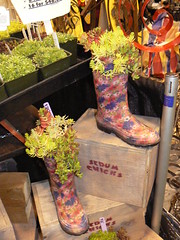
So what did I buy? Not much - a gold-hued sedum and a purple oxalis. I was frugal before frugal was cool.
Monday, February 23, 2009
Today's garden safety tip is brought to you by antibiotics and urgent care
When you sustain a minor injury in the garden, immediately clean the wound, apply some antibacterial ointment, and bandage it up.
Never mind that it's the first halfway warm, sunny weekend day the Northwest has seen since October. Never mind that it's just a scrape, and that's only a little bit of dirt and compost and manure in the wound. Never mind that you really need to get those radish seeds planted, because the wind is kicking up and you're tired and the chickens are loose and might get snatched by hawks if you leave them alone in the yard. Never mind all of that. Clean the damn wound. Now.
I could post a picture of what might happen if you don't, but I wouldn't want you to lose your lunch. Let's just say it involves pain, swelling, a trip to urgent care, antibiotics, and a tetanus shot. Apparently manure has germs in it. Who knew?
Tuesday, February 10, 2009
Hope (for Spring) Springs Eternal!
 Since we're still in the throes of winter, most of the gardening I've been doing lately is of the armchair variety. But February is when the garden really starts to call out to me, both because it always seems to suddenly look like a victim of nuclear apocalypse and because I've been inside looking at seed catalogs for MONTHS now and, jeez, LET'S GO ALREADY!
Since we're still in the throes of winter, most of the gardening I've been doing lately is of the armchair variety. But February is when the garden really starts to call out to me, both because it always seems to suddenly look like a victim of nuclear apocalypse and because I've been inside looking at seed catalogs for MONTHS now and, jeez, LET'S GO ALREADY!Or, be dumb like me and just make it up as you go along. Hey, whatever works. The nice thing about our roses (none of which I can identify for you other than to say that one is light pink with small flowers and the other two have big blooms and are yellow and dark pink, respectively), is that they seem to thrive as long as they are being completely neglected. The more I attempt to do right by them, the more they tend to thumb their nose at me and tell me to mind my own damn business.
Would that the other plants in my garden had that attitude. Stupid lettuce.
Know of anything else we gardeners should be doing in February up here in the deceptively-sunny-yet-still-utterly-freezing Northwest? Edumacate us in the comments!
Sunday, February 08, 2009
Rainy Day Gardening Roundup
- Blunders with shoots, blossoms, 'n roots - a fellow Portlander chronicles her garden experiences
- Weed Whackin' Wenches (oh, how I wish I'd thought up such a cool blog name!) - Two Seattle gardeners with a passion for gardening and chocolate share their wit and wisdom (and recipes--yay!)
- Garden Muse - Another Seattle gardener whose posts are more like photo essays. I wish I had her talent for photography!
- And if you want more garden blogs, check out Blotanical.
Monday, January 26, 2009
New Facebook group for Portland-area gardeners
Tuesday, January 06, 2009
Hits and Misses and Mosses
 I hereby accept my award for Lamest Gardening Blogger Ever and resolve to do better. Thanks for not firing me, Janet, even though I've been AWOL from Rainy Day Gardening since last summer! All I can say is, whew, it all got away from me. The blog AND the garden!
I hereby accept my award for Lamest Gardening Blogger Ever and resolve to do better. Thanks for not firing me, Janet, even though I've been AWOL from Rainy Day Gardening since last summer! All I can say is, whew, it all got away from me. The blog AND the garden!Last spring, I posted a list of goals for the gardening season, and though this is probably obvious at this point, I didn't accomplish many of them.
Completed tasks: Did not let the dandelions win, Removed strange bush from front yard, Added new soil to raised beds.
Not even attempted tasks: All the rest of them.
Some of those not-completed tasks will make it onto this year's list, because I still really want to do them. Others, like trying to get rid of the blackberries in the backyard, are going to change a bit due to the profoundly naive notion of ever being truly rid of blackberries to begin with. That's fighting a losing battle, yo. I only fight battles I can win.
I have lots of plans for both this blog and my garden in 2009. Here are a few of them:

2. Post a monthly list of tasks on this blog, so we all know what we're supposed to be doing each month in our yards. I haven't actually looked this up anywhere yet, but I'd wager that in January, what we're supposed to be doing is: reading seed catalogs while buried under a soft blanket on the sofa in front of the fire. If I learn anything different, I'll let you know.
 3. TAKE NOTES. I keep meaning to diagram my garden each spring when I plant it, and then keep track of how things did in various locations. But I never actually DO it. And it's dumb because then the next year rolls around and I can't remember where I had the petunias that one year when they did so awesome. Was it the back bed? Or the bed up and to the right of the back bed? Crikey. Also, I planted a "wildflower" mix last year that performed dismally, except for one of its flowers, which was utterly majestic. If I'd taken notes on A) where I'd gotten the wildflower mix, and B) what flowers were IN the mix, I might now have a hope of being able to find that flower for this year. Alas, all I know is that the seeds came in, like, some sort of packet dealio, and they were, like, you know -- itty bitty and seed-like.
3. TAKE NOTES. I keep meaning to diagram my garden each spring when I plant it, and then keep track of how things did in various locations. But I never actually DO it. And it's dumb because then the next year rolls around and I can't remember where I had the petunias that one year when they did so awesome. Was it the back bed? Or the bed up and to the right of the back bed? Crikey. Also, I planted a "wildflower" mix last year that performed dismally, except for one of its flowers, which was utterly majestic. If I'd taken notes on A) where I'd gotten the wildflower mix, and B) what flowers were IN the mix, I might now have a hope of being able to find that flower for this year. Alas, all I know is that the seeds came in, like, some sort of packet dealio, and they were, like, you know -- itty bitty and seed-like.
So not helpful.
4. Plant lettuce in a pot. I know last year I said me and lettuce were over. Through. Kaput! But I so desperately want to grow my own lettuce! This year, I'll try it in pots and if it still fails me, I'll give the ring back. For reals. Stupid lettuce.
5. Do something -- ANYTHING -- about the moss. No, not THAT moss. Not the moss in the back yard and the front yard and the side yard -- that's another battle I've discovered is not worth fighting. Now I'm talking about the moss everywhere else. On the roof. On the path to the front door. On the front porch. In my ears. ON MY BRAIN. It must all go. Especially the moss on the roof. It dies first.
6. Plant more coleus. Know why? Because they like me. To wit:
<-- Look at the size of that mutha'!
Okay, so, that's it for my goals so far this year. I have a feeling more will come to me when the weather stops being so miserable and the urge to play in the dirt starts to become overwhelming. In the meantime, I'm really looking forward to another (more prolific, we'll hope) year as co-blogger of Rainy Day Gardening. Ready to work, Janet!



